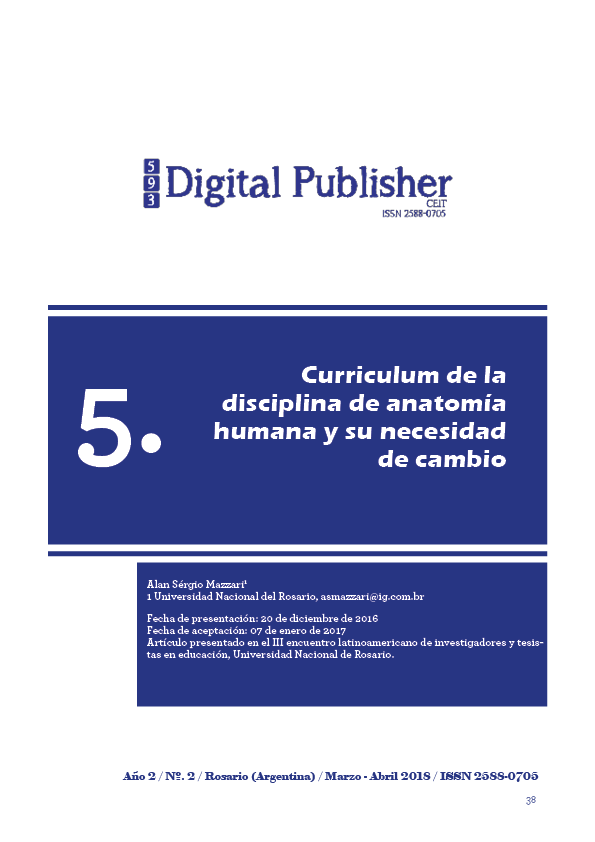Curriculum of the discipline of human anatomy and its need for change
Main Article Content
Abstract
The history of blacks in Brazil has been a history marked by exclusion, despite having had a decisive participation in the construction of Brazilian society. Since the arrival of the first wave of Africans to be enslaved in sugar cane plantations in the captain of São Vicente in 1532 until the passage of the Golden Law in 1888 that banned slavery in Brazil, Blacks were, as has declared Antonil (1982) “the feet and hands of the lords of ingenuity”, but their role in the economic training social and cultural development of Brazil has not received in the history, its value and recognition. This absence of consideration of the participation of the black element in the history has contributed to the discrimination of the persons of dark skin, and this discrimination has caused very serious social reflexes, which it prevents, between other things, the democracy from being a full reality in the Brazilian society.
Downloads
Article Details
1. Derechos de autor
Las obras que se publican en 593 Digital Publisher CEIT están sujetas a los siguientes términos:
1.1. 593 Digital Publisher CEIT, conserva los derechos patrimoniales (copyright) de las obras publicadas, favorece y permite la reutilización de las mismas bajo la licencia Licencia Creative Commons 4.0 de Reconocimiento-NoComercial-CompartirIgual 4.0, por lo cual se pueden copiar, usar, difundir, transmitir y exponer públicamente, siempre que:
1.1.a. Se cite la autoría y fuente original de su publicación (revista, editorial, URL).
1.1.b. No se usen para fines comerciales u onerosos.
1.1.c. Se mencione la existencia y especificaciones de esta licencia de uso.
References
Alba, A. (1998). “Las perspectivas”. Capítulo 3 del libro “Currículum: Crisis, mito y perspectivas”, prólogo de Adriana Puiggrós, Instituto de Investigación en Ciencias de la Educación, Facultad de Filosofía y Letras, Universidad de Buenos Aires, Miño y Dávila Editores, 57-74.
Barrios, G.H. (2006-2007). Curriculum Universitario. Características, Construcción, Instalación. Universidad de Chile, Vicerrectoría de Asuntos Académicos, Dirección de Pregrado, 1-14
Brovelli, M. (2008) El Currículum Universitario y el Enfoque de Competencias. Revista Ciencias de la Educación, Facultad de Humanidades y Artes, 1-21.
Camilloni, A.W. (2001) “Modalidades y proyectos de cambio curricular”. Del libro “Aportes para un cambio curricular en Argentina”, Universidad de Buenos Aires, Facultad de Medicina, OPS/OMS, 23-52.
Díaz Barriga, F., Lule, M., Rojas, S., & Saád, S. (1990) Metodología de Diseño Curricular para la Educación Superior. Universidad Nacional Abierta. Dirección de Investigaciones y Postgrado. México. Trillas (Compilación con fines Instruccionales), 46-53.
Lindo, A. P. (1996) El currículo universitario frente a los cambios en los sistemas de ideas y creencias. Educación Superior y Sociedad, 7 (1), 73-88.
Litwin, E. (2006) “El currículo universitario: perspectivas teóricas y metodológicas para el análisis y el cambio”, revista Educación y Pedagogía, Medellín, Universidad de Antioquia, Facultad de Educación, 23 (46), 25-31.
Nieto-Caraveo, L. M. (2005) “Guía de Discusión sobre Diseño Curricular desde una Perspectiva Procesual”. Capítulo 3 del libro “Alternativas Metodológicas de Intervención Curricular en Educación Superior”. CESU-UNAM, Editorial Plaza y Valdez, FOMIX Guerrero, 1-15.
Zabalza, M. A. (2003) Currículum Universitario Innovador. ¿Nuevos Planes de estudio en moldes y costumbres viejas? III Jornada de Formación de Coordinadores–PE, Europa Punto de Encuentro, Universidad Politécnica de Valencia, Vicerrectorado de Coordinación Académica y Alumnado, 1-23.

